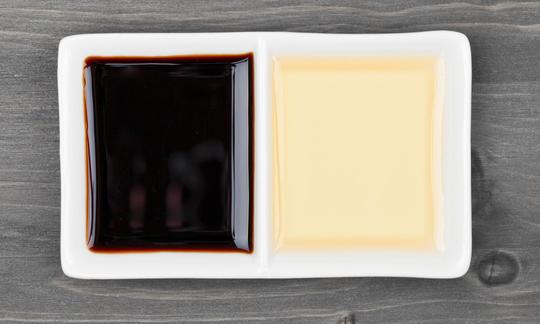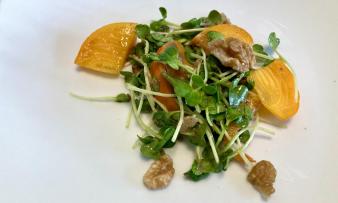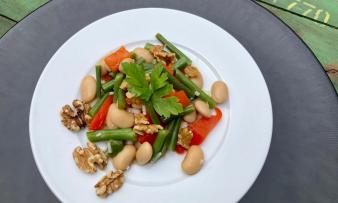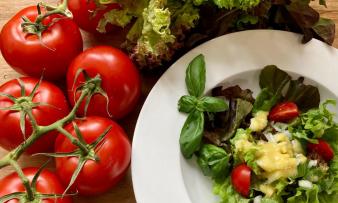Table of contents
White balsamic vinegar (Condimento bianco) (organic) is, depending on the quality, an unripened or ripened fermentation vinegar. It is usually made from white wine vinegar and grape must concentrate.
Use in the kitchen
The sweet and sour vinegar is used in dressings and sauces. The fresh taste of the white balsamic vinegar makes it very popular. It can be combined with a wide variety of oils and refines salads, sauces, dips and soups. Since it does not darken the food, it is particularly suitable for steamed fish and vegetable dishes.
If you compare commercially available white balsamic vinegars, you can see that the acidity of white balsamic vinegar is usually between 5 and 6%. It is slightly milder than its dark relative (Aceto Balsamico di Modena), which must have at least 6% acidity. 5
Vegan recipe for wild garlic vinaigrette:
Ingredients (2 servings): 80 g wild garlic (raw), 3 tbsp white balsamic vinegar (organic), 6 tbsp olive oil (alternatively: rapeseed oil), 1⁄4 tsp sea salt, white pepper.
Preparation: Chop the washed, dabbed wild garlic leaves without the stems into small pieces, mix with the remaining ingredients and puree finely with a blender. This vinaigrette goes perfectly with potato salad.
Vegan recipes with white balsamic vinegar can be found under the note: " Recipes that use the most of this ingredient ".
| Not only vegans or vegetarians should read this: Vegans often eat unhealthily. Avoidable nutritional errors. |
Purchasing - Storage
White balsamic vinegar is available all year round from all supermarket chains such as Coop, Migros, Denner, Volg, Spar, Aldi, Lidl, Rewe, Edeka, Hofer, Billa etc., but the quality is not equally good everywhere. Many industrial products contain fewer grapes and more sugar beet, sugar cane or corn in combination with acetic acid. In selected supermarkets, delicatessens or online shops you can find variants that are made from single-variety grapes (e.g. Trebbiano grapes), some from organically grown grapes and sometimes stored in wooden barrels. This special storage gives the vinegar an amber-like color.
If you prefer organic vinegar, it is not contaminated with chemicals (pesticides) and does not contain any colorings.
Not only dark balsamic vinegar can come from the Modena region (Italy), white balsamic vinegar can also bear this designation of origin. The abbreviation IGP, which means "Indicazione Geografica Protetta" (protected geographical origin), is often found. However, it only defines that one stage of production took place in this region. The abbreviation DOP "Denominazione d'Origine Protetta" also stands for a protected designation of origin and identifies all production in the region mentioned. Products that have the addition "Tradizionale" are only on the shelves after a minimum maturation period of 12 years. 3 White balsamic vinegar does not mature for as long as dark balsamic vinegar.
The availability of balsamic vinegar varies depending on the size of the store, catchment area, etc. If you are interested, click on our recorded food prices for the DA-CH countries (above under the ingredient image). There you will find current prices from various supermarkets and their price development.
Tips for storage
Vinegar does not need a best-before date. If vinegar is kept in a cool place, protected from light and hermetically sealed, it will last for a very long time. Opened products will last for several months if well sealed. If the vinegar is stored for too long, its aroma can lose its flavor in opened bottles. If mold grows on the surface, the vinegar is spoiled and no longer edible. Streaks and threads in the vinegar or sediment are harmless. A gelatinous mass forms, the mother of vinegar: it consists of active acetic acid bacteria. 16
Ingredients - Nutritional values - Calories
Both names 'White Balsamic Vinegar' and 'Condimento bianco' are not subject to any legal restrictions in their composition. Only the general food regulations apply. 3 Therefore, the ingredients and the associated nutritional value can differ greatly.
With this background knowledge – here is just an outline of the macronutrients:
The white balsamic vinegar has 110 kcal/100g, 0.50 g/100g fat, 24 g/100g carbohydrates (22 g sugar) and 0.20 g/100g protein. 1
The complete ingredients of the white balsamic vinegar, the coverage of the daily requirement and comparison values with other ingredients can be found in our nutrient tables. In the article Nutrients explained you will get a detailed insight into the topic.
Health effects
White balsamic vinegar mostly consists of white wine vinegar and grape juice concentrate. The main phenolic compounds that researchers have found in white wine vinegar are: protocatechuic acid, caffeic acid, p-coumaric acid and ferulic acid. 6
Protocatechuic acid: The pharmacological effects of protocatechuic acid (PCA) include potent antioxidant activity both in vitro and in vivo. In vivo experiments in rats and mice showed that PCA has anti-inflammatory, antihyperglycemic and antiapoptotic (cell death prevention) effects. Moreover, PCA was found to inhibit chemical carcinogenesis. Furthermore, in vitro studies have shown that PCA has antimicrobial activities and also shows synergistic interaction with some antibiotics against resistant pathogens. 7
Caffeic acid: Scientific evidence suggests that caffeic acid has potential anti-inflammatory, anti-carcinogenic and antiviral effects. Caffeic acid is also an antioxidant that can reduce oxidative stress caused in the body by the action of free radicals. Oxidative stress is defined as an imbalance between the production of reactive oxygen species and the antioxidant defense. As a result of this imbalance, oxidative stress is often responsible for the development or worsening of diseases, including cancer, atherosclerosis, cardiovascular disease, Parkinson's, Alzheimer's and many others. 8
p-coumaric acid: Studies have shown that p-coumaric acid has various bioactive properties, including antioxidant, anti-inflammatory, antimutagenic, gastroprotective, anti-coagulant and anticarcinogenic activities, reduction of atherosclerosis, oxidative myocardial damage, UV-induced damage to eye tissues, neuronal injury, anxiety, gout and diabetes. 9
Ferulic acid: The ubiquitous compound 4-hydroxy-3-methoxycinamic acid, also known as ferulic acid (FA), is a bioactive component of many foods that may provide beneficial effects against disorders related to oxidative stress, including cancer, diabetes, and neurodegenerative diseases. Ferulated natural products have been shown to exhibit not only antioxidant activities, but also cytotoxic, anti-inflammatory, antimicrobial, and other effects, which are at least partially related to their antioxidant activity against reactive oxygen species (ROS) due to the presence of a feruloyl group. 10
The most important organic acids in white wine vinegar are tartaric acid and succinic acid. 6
Tartaric acid: The results of a study suggest that tartaric acid may have beneficial effects on intestinal function. Tartaric acid also appears to potentially reduce the risk of colorectal cancer. 11
Succinic acid: Succinic acid is a natural intermediate product of metabolism that occurs in every cell in the body. It plays an important role in energy conversion in the mitochondria. Succinic acid supports the recovery processes in cases of heart and kidney disease, age-related disorders of the nerve centers, intensive muscle work and exposure to toxins. It lowers the oxygen content in the cells and reduces the formation of free radicals. Stress or exertion can disrupt the balance of succinic acid in the body. Succinic acid can penetrate cells and influence their activity in order to restore homeostasis (balance of physiological body functions). In the treatment of diabetes, succinic acid is used to lower cholesterol and fatty acid levels in the blood, reduce the need for insulin and stimulate the body's own insulin production. Succinic acid and glucose increase physical performance, make it easier to adapt to physical exertion and reduce muscle pain. Positive effects of succinic acid have been found in cardiovascular diseases, bronchitis, strokes, flu, colds, tuberculosis, alcoholism and allergies. Succinic acid and its salts are used as diuretics, laxatives, anti-inflammatory and anti-anemic agents. 12
Succinic acid is produced naturally during the winemaking process, 14 and the wine is then used to produce white wine vinegar.
The second basic ingredient is grape juice concentrate or grape must.
Is grape must healthy? Grape must contains all the components of the grape, while grape juice is the extracted liquid without any solid components. Grapes contain significant amounts of organic acids, with tartaric acid being the main acid in grape juice. Phenols include flavonols, anthocyanins, flavan-3-ol monomers, proanthocyanidins, and hydroxycinnamic acids. Grape juice contains various minerals, with potassium being the dominant cation. 14 The health effects of grape must could probably be compared to those of wine grapes.
Is balsamic vinegar healthy? Acetic acid is an essential component of white balsamic vinegar. Research has shown the powerful bioactive effects of vinegar that can benefit human health. Functional therapeutic properties of vinegar include antibacterial activity, lowering blood pressure, antioxidant activity, reducing the effects of diabetes, and preventing cardiovascular disease. Other positive health effects of consuming vinegar include improved blood sugar response, which may be beneficial for diabetics. Phenolic acids in vinegar can scavenge excess anions and free radicals and possess strong antioxidant activity. Depending on the type of vinegar and the content of acetic acid and total phenols, daily consumption of vinegar can affect human health and metabolism. 15 For more health effects of balsamic vinegar, see the ingredient balsamic vinegar (aceto balsamico) and white wine vinegar.
Dangers - Intolerances - Side effects
Excessive and chronic consumption of vinegar can cause serious health problems. There have been cases of high excretion of potassium, sodium and bicarbonate in the urine, as well as stimulation of plasma renin activity in the blood plasma in patients who have consumed large amounts of vinegar over a long period of time. One patient consumed about 250 ml of vinegar (12.5 g acetic acid) daily and had to be hospitalized with hypokalemia (disturbance of the electrolyte balance). There are also reports of injuries to the mucous membranes of the mouth and esophagus caused by vinegar and chemical burns to the skin caused by the use of vinegar to treat skin conditions. Media reports can lead to incorrect use of vinegar as a therapy, and it is important to be aware of the risks and potential side effects. 2
Apart from excessive consumption, one should pay attention to the additives in white balsamic vinegar: glucose syrup, caramel, natural or modified starch (corn [E1422], potato, wheat, etc.), xanthan gum (E415), guar gum (E413), pectins, dextrose, locust bean gum and lactose, among others. 3
Caramel is one of the oldest and most widely used food colors. Caramel color is approved for use in food worldwide, but application regulations vary by country. Caramels, particularly those made with ammonium salts (E150c and E150d), are the subject of controversial safety concerns due to the presence of 4-methylimidazole (MEI). Some public safety organizations (e.g. FDA, EFSA) consider caramel to be safe and consistent with good manufacturing practices in the amounts commonly used in food. 3
Glucose syrup is obtained by chemical or enzymatic hydrolysis of starch from various plants such as corn, rice and potatoes. In balsamic condiments and balsamic vinegar, glucose syrup is often added to increase the viscosity of products and indirectly other sensory properties such as sweetness, which is a complex perception related to the concentration of simple sugars but also viscosity.
Ecological footprint - animal welfare
The ecological footprint of white balsamic vinegar depends on many factors. A significant step in the production process and the resulting emissions is the cultivation of the grapes. The input factors of cultivation, such as energy (e.g. diesel for tractors), pesticide use, fertilizers, irrigation and land use changes are crucial. These factors differ greatly between organic and conventional wine production. Regardless of the cultivation method, the production and storage of balsamic vinegar can influence the ecological footprint. Packaging, distribution and the end of life of the packaging all contribute to the calculation. 18 We did not find exact figures for the ecological CO2 footprint of balsamic vinegar, but we did find figures for wine. Wine and balsamic vinegar can be compared because they are made from the same agricultural product.
In a study of the carbon footprint of the wine industry, diesel fuel consumption emerged as the main source of negative environmental impacts. A comparison of conventional and biodynamic viticulture revealed a big difference, as conventional agriculture uses synthetic pesticides and fertilizers, which have a negative impact on the environment and increase the ecological footprint. In addition, different studies on the CO 2 balance of wine were compared and values between 0.22 kg CO 2 eq/kg and 2.66 kg CO 2 eq/kg were found. 19 The Big Climate Database gives an ecological CO 2 footprint of an average of 1.87 kg CO 2 eq/kg for wine. 20
Packaging processes are another key issue, mainly due to the production of glass bottles. On average, this component of the life cycle accounts for around 20-22% of the total CO 2 equivalent value of a wine bottle. 19 Elaborately designed, heavy, disposable glass bottles have a very negative impact on the environmental impact. 21 To produce 1 kg of wine, around 870 l of water is needed. 22 To produce 1 l of aged vinegar, between 1332 and 1892 l/l is needed. 17
Worldwide occurrence – cultivation
The most commonly used Trebbiano grape can be found in a wide variety of countries. This grape variety originally came from Italy and found its way to Argentina, Bulgaria, France, Austria and many other countries. 13
Production
White balsamic vinegars can vary greatly in their composition and production. What they all have in common is that they contain more or less grapes.
In the traditional production of 'Aceto Balsamico', the grapes are first boiled, which creates the dark color in a Maillard reaction. The long storage in wooden barrels concentrates the color-giving melanoidins created in the Maillard reaction—the vinegar darkens even more. In white balsamic vinegar, these processes are omitted or greatly shortened. This is why in the country of origin of balsamic vinegar, Italy, white balsamic vinegar is not called 'Aceto Balsamico bianco', but is given its own distinct name: Condimento bianco. 3
Now the question arises: Is ‘Condimento bianco’ white wine vinegar?
'Condimento bianco' is not the same as 'white wine vinegar'. Although both 'Condimento bianco' and 'white wine vinegar' are light vinegars made from grapes, the difference lies in the raw material.
'Condimento bianco' is an Italian vinegar made from grape must, which is made from the freshly pressed juice of white grapes. It undergoes a maturation and fermentation process similar to traditional balsamic vinegar, but for a shorter period of time.
White wine vinegar, on the other hand, is produced by fermenting white wine into vinegar. White wine vinegar has a more pronounced sour taste.
Although both 'Condimento bianco' and white wine vinegar are used in similar culinary applications, the two vinegars taste different.
White wine vinegar is, on average, much cheaper. Since the grapes are not concentrated or cooked, the yield is higher.
Further information
What is Condimento bianco? What is white balsamic vinegar?
To understand what 'white balsamic vinegar' or 'Condimento bianco' is, you should look at the categories of balsamic vinegar:
- Balsamic vinegar with protected geographical indication (from Modena or from Reggio Emilia): This refers to the protected name 'Aceto Balsamico di Modena', a product produced according to a set standard and submitted to the European Commission for recognition as a protected geographical indication. Aceto Balsamico di Modena is produced by mixing cooked and/or concentrated grape must, at least 10% wine vinegar, a small amount of vinegar aged for 10 years and sometimes caramel colouring (up to 2%). The proportion of cooked and/or concentrated grape must must be more than 20% of the total volume. Other substances are not allowed. Maturation takes place for at least 60 days or more than 3 years for the designation "invecchiato". 3
- Balsamic vinegars with a higher level of legal protection, which have a protected designation of origin, are the traditional balsamic vinegar from Modena or Reggio Emilia. The only ingredient is cooked grape must. This is fermented to make vinegar and then stored in a series of barrels to age for at least 12 years. A group of trained tasters evaluates the sensory characteristics of each batch. 3
- Balsamic glazes, sauces and jellies without any legal protection are called balsamic condiments. They may have similarities to Balsamico di Modena or traditional balsamic vinegar from Modena or Reggio Emilia. Liquid or very viscous consistencies are possible and can be thickened if necessary by adding starch or other additives. Balsamic condiments can contain mixtures of vinegars from different origins (wine, fruit, malt, etc.) together with grape must, fruit juices, sugar and food additives to achieve the desired appearance and texture. 3
- Balsamic vinegar: without reference to a recognized geographical origin. These products must comply with the general vinegar regulations, which vary from country to country, and are not subject to any other restrictions on composition and maturation. 3
White balsamic vinegar falls into the latter two categories. White balsamic vinegar is only a distant relative of the traditional Aceto Balsamico. Conservatively speaking, the unifying characteristic of balsamic vinegars is the sweet and sour taste and the dark color. 4 Therefore, the word combination 'white balsamic' could be considered an oxymoron. 3
What is Condimento? The word Condimento comes from two Latin words: 'condimentum' and means 'spice, seasoning, sauce' and 'condere', 'to preserve, to pickle, to season'. 4 'Condimento' therefore only indicates that it is a seasoning sauce.
Alternative names
There are many different names in circulation, although they are not necessarily correct. White balsamic vinegar is called 'condimento bianco', 'white balsamic', 'condimento bianco', 'balsamic vinegar white', 'balsamic bianco', 'white wine vinegar condimento bianco'.
Bibliography - 22 Sources (Link to the evidence)
| 1. | US-Amerikanische Nährwertdatenbank USDA. 2019. |
| 2. | Santos HO, de Moraes WMAM, da Silva GAR, Prestes J, Schoenfeld BJ. Vinegar (Acetic acid) intake on glucose metabolism: A narrative review. Clinical Nutrition ESPEN. August 2019;32:1–7. |
| 3. | Giudici P, Lemmetti F, Mazza S. Balsamic vinegars: Tradition, Technology, Trade. 1st ed. 2015. Cham: Springer International Publishing : Imprint: Springer; 2015. 1 S. |
| 4. | James FT. Balsamic Vinegar: A history, introduction to key styles and more [E-Book]. 2018. |
| 5. | Aceto Balsamico di Modena. Indicazione Geografica Protetta. Disciplinare di produzione. |
| 6. | Liu Q, Tang GY, Zhao CN, Gan RY, Li HB. Antioxidant activities, phenolic profiles, and organic acid contents of fruit vinegars. Antioxidants. 27. März 2019;8(4):78. |
| 7. | Semaming Y, Pannengpetch P, Chattipakorn SC, Chattipakorn N. Pharmacological properties of protocatechuic acid and its potential roles as complementary medicine. Evidence-Based Complementary and Alternative Medicine. 2015;2015:1–11. |
| 8. | Birková A, Hubková B, Bolerázska B, Mareková M, Čižmárová B. (2020). Caffeic acid: A brief overview of its presence, metabolism, and bioactivity. Bioactive Compounds in Health and Disease. 2020;3(4):74-81. |
| 9. | Pei K, Ou J, Huang J, Ou S. p -coumaric acid and its conjugates: dietary sources, pharmacokinetic properties and biological activities: p -coumaric acid and its conjugates. J Sci Food Agric. Juli 2016;96(9):2952–62. |
| 10. | de Oliveira Silva E, Batista R. Ferulic acid and naturally occurring compounds bearing a feruloyl moiety: a review on their structures, occurrence, and potential health benefits. Comprehensive Reviews in Food Science and Food Safety. Juli 2017;16(4):580–616. |
| 11. | Spiller GA, Story JA, Furumoto EJ, Chezem JC, Spiller M. Effect of tartaric acid and dietary fibre from sun-dried raisins on colonic function and on bile acid and volatile fatty acid excretion in healthy adults. Br J Nutr. Oktober 2003;90(4):803–7. |
| 12. | Barczak PM. Amber Elixir of Immortality: Health properties of compounds with pharmacological action. Chemical compounds of Baltic amber. Succinite- scientific research on dementia and Alzheimer's disease [E-Book]. Royal Brand. 2021: |
| 13. | Anderson K, Nelgen S. Which Wine Grape Varieties are Grown Where? [E-Book]: A Global Empirical Picture. Vereinigtes Königreich: University of Adelaide Press. 2020. |
| 14. | Moreno J, Peinado R. Enological chemistry. 1st ed. London ; Waltham, MA: Academic Press; 2012:13-22. |
| 15. | Budak NH, Aykin E, Seydim AC, Greene AK, Guzel-Seydim ZB. Functional properties of vinegar: functional properties of vinegar. Journal of Food Science. Mai 2014;79(5):R757–64. |
| 16. | López F. Post-Fermentation Treatments of Vinegars. In: Bekatorou A, Hrsg. Advances in Vinegar Production. Vereinigtes Königreich: CRC Press; 2019:327-338. |
| 17. | Bartocci P, Fantozzi P, Fantozzi F. Environmental impact of Sagrantino and Grechetto grapes cultivation for wine and vinegar production in central Italy. Journal of Cleaner Production. Januar 2017;140:569–80. |
| 18. | Litskas V, Mandoulaki A, Vogiatzakis IN, Tzortzakis N, Stavrinides M. Sustainable viticulture: first determination of the environmental footprint of grapes. Sustainability. 23. Oktober 2020;12(21):8812. |
| 19. | Scrucca F, Bonamente E, Rinaldi S. Carbon footprint in the wine industry. In: Environmental Carbon Footprints [Internet]. Elsevier; 2018:161–96. |
| 20. | CONCITO. The Big Climate Database, version 1. 2021. |
| 21. | Tsalidis GA, Kryona ZP, Tsirliganis N. Selecting south European wine based on carbon footprint. Resources, Environment and Sustainability. September 2022;9:100066. |
| 22. | Mekonnen MM, Hoekstra AY. The green, blue and grey water footprint of crops and derived crop products. Hydrol. Earth Syst. Sci. 2011; 15: 1577-1600. |








Comments